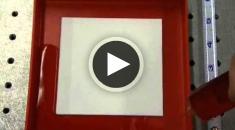The America’s Next Top Energy Innovator Challenge, a part of the Startup America initiative, made it easier for start-ups to use inventions and technology developed at the U.S. Department of Energy’s 17 National Laboratories and the Y-12 National Security Complex.
The companies highlighted below signed option agreements allowing them to license valuable, cutting-edge technologies from one of the labs.
You can see the winners of the 2012 competition here.
We counted your 'likes' and then left it up to the panel of experts to evaluate which three of these companies are selected to attend the 2012 ARPA-E Energy Innovation Summit, the premier annual gathering of clean energy investors and innovators around the country.
Innovators
7AC Technologies, based in Woburn, Massachusetts, is developing Liquid Desiccant HVAC systems for Commercial and Industrial buildings using technology from the National Renewable Energy Laboratory. These Liquid Desiccant HVAC systems deliver a 50 to 75 percent reduction in energy usage over conventional HVAC units. The system consists of a membrane conditioner responsible for drying and cooling the air and a heat-driven regenerator. The liquid desiccant design allows for the utilization of solar or waste heat sources, paving the way for net-zero energy retrofits to existing buildings with costs comparable to conventional HVAC.
Vorbeck Materials, based in Jessup, Md., is using a Pacific Northwest National Laboratory (PNNL)-developed method for building tiny chemical structures to greatly improve the performance of lithium-ion batteries. Lithium-ion batteries are rechargeable batteries that are widely used in portable devices such as laptops and power electric vehicles. Vorbeck is using PNNL’s method to develop better lithium air and lithium sulfur batteries. The new material in Vorbeck’s batteries stores twice as much electricity at high charge and discharge rates as current lithium-ion batteries, and creates increased battery capacity and a longer cycle life.
US e-Chromic LLC, based in Boulder, Colorado, will use electrochromic technology developed by the National Renewable Energy Laboratory (NREL) to create a new thin film window material that reflects sunlight on demand, making windows more energy efficient while reducing cooling costs for consumers.
Umpqua Energy, based in Medford, Oregon, is using an Argonne National Laboratory technology to develop a system that allows a gasoline engine to operate in an extreme lean burn mode in order to increase gasoline mileage. One negative side effect of a lean burn engine, whether powered by gasoline or diesel fuel, is an increase in the amount of harmful gases released to the environment. The company expects to both increase fuel economy and simultaneously reduce emissions with its system.
Borla Performance Industries, based in Johnson City, has an option to license a novel, nano-pore membrane technology from Oak Ridge National Laboratory. Combining this innovation with Borla’s exhaust technology will lead to a low cost, unique exhaust system that will double as an energy neutral device to recover and reclaim clean water from engines powered by diesel, gasoline or natural gas. Military and commercial applications include transport and stationery power plants, marine, cars and trucks.
TrakLok, Inc., based in Knoxville, Tenn., intends to use an Oak Ridge National Laboratory (ORNL)-developed, technology for tagging, tracking, locating and communicating with cargo containers and trailers in transit. The ORNL technology provides an avenue to meet increasing requirements for shipping containers to be "smart boxes" that can be tracked electronically. TrakLok uses GPS technology and satellite communications as part of its tracking and warning capability and international container locking technology to protect against container tampering, theft, vandalism and smuggling. Shipments can be tracked through a web-accessible, information technology-based global tracking system to provide real time visibility of cargo.
California Lithium Battery (CaLBattery), based in Los Angeles, California, is developing a low-cost, advanced lithium-ion battery that employs a novel silicon graphene composite material that will substantially improve battery cycle life. When combined with other advanced battery materials, it could effectively lower battery life cycle cost by up to 70 percent. Over the next year, CALBattery will be working with Argonne National Laboratory to combine their patented silicon-graphene anode material process together with other advanced ANL cathode and electrolyte battery materials.
Woodmont Enterprises, based in Nashville, Tennessee, is creating a top-coat solution moisture barrier product for oriented-strand board (OSB), an engineered wood product formed by layering flakes of wood, by using technology developed at Oak Ridge National Laboratory. The primary focus is to create a moisture barrier on OSB during transportation and after installation. One net benefit to moisture protected OSB after installation is mold resistance.
SH Coatings, based in Dallas, Texas, employs Super Hydrophobic Coating (SHC) technology that protects power systems by preventing ice accumulation on power lines in ice storm threatened areas and contamination of power lines from salt on the coasts. In order to successfully utilize and commercialize the SHC technology for this application, tools to apply the coating onto new and existing lines must be developed. SH Coatings is developing these tools with the help of technology from Oak Ridge National Laboratory.
Iowa Powder Atomization Technologies, Inc. (IPAT), based in Nevada, Iowa, is using gas atomization technology developed at Ames Laboratory to make titanium powder with processes that are ten times more efficient than traditional powder-making methods — significantly lowering the cost of the powder to manufacturers. The powder form of titanium is easier to work with than having to cast the metal — where manufacturers melt and pour liquid metal into molds — particularly given titanium’s tendency to react with the materials used to form molds. Titanium’s strength, light weight, biocompatibility and resistance to corrosion make it ideal for use in a variety of parts — from components for artificial limbs — like those used by wounded veterans returning from Iraq and Afghanistan — to military vehicle components, biomedical implants, aerospace fasteners and chemical plant valves.
Teknikem is developing a chemical blend platform technology invented by the Y12 National Security Complex that is known as RonJohn. RonJohn is a safer, more eco-friendly alternative to dangerous chemicals and processes used to strip paints and adhesives from parts and equipment. RonJohn is not toxic, not flammable, not carcinogenic but is biodegradeable and very effective on many plastics, paints, and adhesives. Market segments and channels are being developed including the military, aerospace, shipping construction/maintenance, ground transportation, general industry, and consumer retail.
SynchroPET, based in Shoreham, New York, is a start-up biotech firm with the next generation of PET Scanners, which have superior imaging capabilities to what is currently available on the market today. SynchroPET's technology was developed at Brookhaven National Laboratory and it enabled SynchroPET to miniaturize the typical PET Scanner while improving its image. SynchroPET's technology can be paired with an existing MRI machine for a simultaneous image. These advances will accelerate the creation of new pharmaceuticals to treat cancers, and Alzheimer and Parkinson’s diseases. SynchroPET currently has four prototypes built, and each have been used by researchers from labs in New York.
Integrated Dynamic Electron Solutions, Inc., based in Belmont, California, uses Dynamic Transmission Electron Microscopes (DTEM) to enable imaging of nanoscale objects, such as proteins, thin films and nanoparticles at unprecedented time scales and frame rates. By utilizing a laser-driven electron source, DTEMs are able to produce short bursts of electrons that can form an image with nanometer resolution in as little as 10 nanoseconds. This enables observation of dynamics in material systems that play an important role in a wide range of energy technologies, including battery electrodes, petroleum catalysts, solar cell materials, and organisms for bio fuel growth. Integrated Dynamic Electron Solutions uses technology developed at Lawrence Livermore National Laboratory.
Element One, based in Boulder, Colorado, has created the only available coatings that change color when detecting hydrogen and other hazardous gas leaks, either reversibly or non-reversibly, to provide both current and historical information about leaks. Element One’s patented gas indicators and sensors use catalyzed thin films or nanoparticles of a transition metal oxide to create very low cost sensors for use in industrial and consumer environments, greatly reducing the potential for undetected leaks and their cost and safety implications. This technology is also being integrated for use in refineries, industry gas and fuel cells systems and was developed using technology from the National Renewable Energy Laboratory.
















